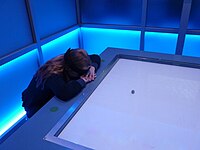Mindball
Mindball (or Mindball Game ) is a game in which 2 to 6 players compete against each other in order to let a ball roll towards the opponent through concentration, relaxation and intellectual focus. The brain activity of the opponents is registered by means of biosensors in a headband and transferred to a ball controlled by a magnet. The ball rolls back and forth between the opponents on a table controlled by a magnetic slide mounted under the table. If the ball reaches the opponent's "goal", you win. The Mindball game is manufactured and distributed by the Swedish company Interactive Productline.
history
The Mindball game emerged from the Brainball, a development by the Interactive Institute from Sweden. This institute was founded in 1998 and conducts academic research in the field of technology and design as well as research at the interface between art, design and technology.
function
The Mindball game falls under the category of neurofeedback , a special form of biofeedback . The alpha and theta waves of the brain are measured and analyzed in real time by computer and projected onto the movement of the ball. The voltage fluctuations are displayed on a screen in the form of an EEG .
- Theta waves
- A signal in the frequency range between 4 and <8 Hz is called a theta wave. They occur more frequently in the light sleep phases, and one only reacts to important or strong environmental stimuli.
- Alpha waves
- A signal in the frequency range between 8 and 13 Hz is called an alpha wave. An increased proportion of alpha waves is associated with slight relaxation or relaxed wakefulness with closed eyes. Alpha waves are considered to be an emergent property. Alpha waves mainly occur when the eyes are closed and immediately transition into the beta range when the eyes are opened. The same effect can be achieved with closed eyes, if you z. B. begins to solve a simple arithmetic problem in your head.
Rules of the game
The aim of the game is to let the ball roll into the opponent's goal. It is not allowed to touch the ball with your hands. It all depends on brain activity. The more uniform and long-wave a player's alpha and theta waves, the better their chances of winning. If the ball has reached a player, he has lost. You can, of course, reverse the objective by trying to be as excited and unfocused as possible to get the ball into your own goal.
therapy
Neurofeedback is becoming more and more important in relation to various diseases and disorders, such as B. ADHD or insomnia. The playful approach is particularly suitable for children, and various studies have already provided evidence that regular neurofeedback training can reduce or even replace medication. Neurofeedback is also becoming more and more popular in business and is used there for consulting , coaching , anti-stress seminars and management training.
See also
- NeuroSky, brain-computer interfaces. Leader in the field.
- Neural Impulse Actuator Headset based on neurofeedback and EMG for computer games
- Emotiv Systems - headset based on neurofeedback for computer games
- German Mindball homepage
Individual evidence
- ↑ Gevensleben, H. et al: Is neurofeedback an efficacious treatment for ADHD? A randomized controlled clinical trial doi : 10.1111 / j.1469-7610.2008.02033.x .
- ↑ Mindball http://www.mindball-verleih.de/mindball.php
- ↑ Heise article on computer-brain interfaces
